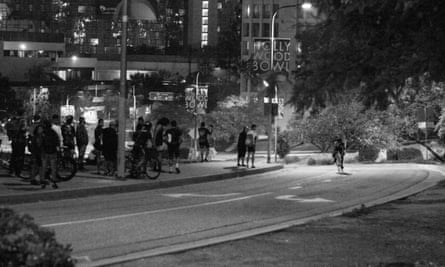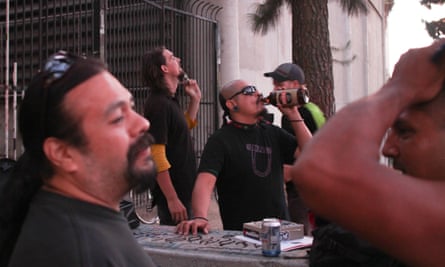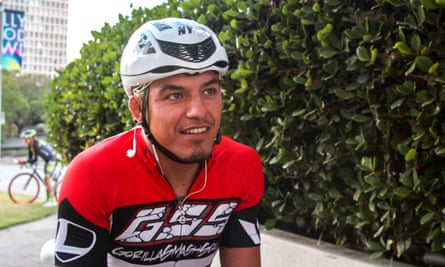A golden moon hung over the city, and as night deepened the crowd lounging off Hope Street grew giddy. People swigged beer, marijuana spiced the air, hip-hop streamed from a sound system. It felt like a gritty picnic, minus food.
A yell from a guy with a Hawaiian shirt and a clipboard signalled business, however, and the hundred-strong crowd promptly lined the sidewalk, expectant. The race was about to begin. About two dozen riders, many in Lycra, some in jeans, gathered at a traffic light with their eyes fixed on the race marshal, a ragged figure with a raised baton.
The contest that followed was noteworthy for several reasons. Some competitors had been among the boozers and smokers. The marshal was a homeless man who sleeps under a nearby bush. There were no traffic cones or markings delineating the route. And most striking of all: this guerrilla bicycle event unfolded in the heart of the world’s car capital, Los Angeles.
“You ride at your own risk,” said Angel Rodriguez, 21, a competitor awaiting the start signal. “Once you realise you’ve just missed a car you get an adrenaline rush.” Is near death a deterrent? He shook his head and grinned. “You use that. You convert that into more speed.” Moments later the cyclists swooshed off, legs like pistons, battling for dominance as they the hurtled past the darkened skyscrapers of downtown LA.
This was a real-life, two-wheeled version of The Fast and the Furious, a sub-culture of bicycle tribes that claims LA’s streets by night. Dozens of groups, big and small, with names like the Wolfpack Hustle, Ovarian Psycos Bicycle Brigade and Kushtown Society, hold races and mass rides on streets originally designed solely for cars. There are events most nights: some wild and illegal, others blessed by city authorities. And they go anywhere, improvising routes from Boyle Heights to Pasadena, Hollywood to Compton, up Mulholland Drive, down Griffith Park, through Beverly Hills, around Silver Lake, back down Sunset Boulevard.

“LA is being dragged kicking and screaming from car culture little, tiny bits at a time,” said Don Ward, AKA “Roadblock”, a 43-year-old organiser and figurehead. He got the nickname using his 6ft 8in bulk to block traffic in order to let fellow cyclists pass, and is the closest thing to a spokesman for this vibrant, fractious, leaderless movement. Although they have challenged the car-is-king mentality, they have a long way to go, said Ward. “Racing culture is still looking for its place in the mainstream.”
That quest for acceptance – and for safe bicycle lanes – has united an eclectic coalition that cuts across race and class lines. There are lawyers and janitors, hipsters and gang members, feminists and bros. Their success can be measured in the increasing number and visibility of officially sanctioned events, day and night.
“It was frowned upon a while ago but the LAPD are way more understanding now. And the whole Department of Transport is totally about bikes,” enthused Jungle, 40, a founder of DTLA Messengers, the group that hosted the recent Hope Street race. Even with officialdom apparently onside, however, Jungle declined to give his real name.

The movement originated about two decades ago as a spin-off from San Francisco’s Critical Mass community ride. LA cyclists, until then lonely, quixotic figures, felt emboldened to organise their own rides, using force of numbers to co-exist with traffic in mass rides, and for races acting like flash mobs, briefly sealing off an alley here, a boulevard there.
“They were taking over the streets, running red lights. The police were having a hard time controlling them,” recalled Gordon Helper, LAPD’s senior lead bike officer. “They were in and out so fast we didn’t know about it half the time.”
By 2006 an umbrella group, the Midnight Ridazz, had so many people flocking to its monthly rides that Ward created an online forum to encourage people to form off-shoots with their own identities and rides.
A decade later, countless groups have formed: Sins and Sprockets, MOM Ridaz, Los Angelopes, Pier Pressure, Taco Tuesday, Westside Mosey. Some endure, others are fleeting. “There are so many different rides right now it’s not funny,” said Helper.

City authorities were initially suspicious. There were accidents and confrontations with motorists. A rowdy fringe took to raiding liquor stores, spraying graffiti and flaunting marijuana.
Helper, a triathlete, attended some rides off-duty and concluded that the riders were not, in fact, hooligans bent on anarchy. “They weren’t committing violent crimes. What I saw was a lot of kids who might have gone the gang route getting into bicycling and racing. Some have become really good. They got pushed in a different direction.”
The evolution of the Kushtown riders vindicated such faith. Formed mainly by latino teenagers, the name was a play on their Koreatown neighbourhood and passion for kush and other strains of marijuana. “It was about getting some beers and weed and hanging out on bikes,” said Hansel Echevarria, 25, a co-founder.
Rowdy elements used to steal booze and stir trouble, Echeverria recalled. “So I put my foot down. That’s not what we’re about. We rebranded ourselves as the Kushtown Society. Now we’re more civilised.”

Beer and pot were still welcome, he stressed, but the vibe is chilled, not chaotic, and participants are expected to be fit for fast rides of up to 60 miles. “We want to show people we’re not your regular cannabis consumer. We’re active and athletic, not some lazy potheads lying on a sofa.”
Some former Kushtowners have graduated to sponsorship deals and professional racing, notably Edgar Juarez, AKA Willo, a former gang member who served time in jail and is now a celebrity for his racing exploits. “It’s an outlet, a form of escape from the ghetto. You’re hanging out with people from the hood, with architects, all sorts,” said Willo. He smiled, revealing missing teeth, legacy of a nasty collision.
Willo was speaking at the race on Hope Street, the last of five races held downtown every summer by the DTLA Messengers. It was formed by couriers who work mainly for legal firms. Zipping through LA traffic on two wheels for a living renders them fearless. Or possibly a bit unhinged.

“They rebuilt my face,” said Ozzie, 39, indicating two holes and a scar across his skull, which he got after a bus collision that for a time put him on life support. He resumed biking as soon as he could. “You won’t make the big bucks but it’s like a big family, man. You’re not in an office, you’re out, free.”
The Messengers gather on the same corner at the end of the working week to share beers and joints and maybe race, depending how much they consume. “When I race I do it under the influence,” said Ozzie. “Liquid courage. It relaxes me.”
Another messenger, Animal, 31, regarded his Negra Modelo and shook his head. “I’m not racing tonight. I’m already a little drunk.” Charles Cetto, 37, sipping an IPA, said it would make no difference. “We get so drunk we don’t remember who won.”

He was joking. Few got wasted and everybody was keen to watch the two races, comprised of 13 circuits of a downtown loop done on multi-speed and single-speed bicycles. A few years ago, contestants chugged beers and wore jeans; most are now abstemious and decked out with professional cycling equipment.
“I used to be about fast food but now I’m about salad,” said Manuel Barra, 22, a star member of the the Green Leaf Killer team (motto: Ride. Hustle. Kill. Repeat.) A restaurant and a trucking company sponsored the gear.
Barra’s main rivals in the single-speed category were Willo and a rider nicknamed Neu York, representing the Gorilla Smash Squad. Perils included Prius cars, which can be fatally quiet, and traffic lights, said Neu York. “Red lights are one of the dynamics. You have to strategise.”
The races passed in a blur: riders whipping down Hope Street, swerving on to Flower Street, belting through a tunnel of roaring traffic and blinding headlights and back up to the starting point. They did it 13 times, no one crashed, and everyone, save the two police officers monitoring from a distance, cheered.

Barra pipped Neu York to claim first place. He received the $80 prize ($5 entry fees paid by the 16 riders in his category) beneath a victory arch made of empty beer boxes. For the serious riders, this outing was a warm-up for the Wolfpack Hustle race on 15 August, which drew international contestants.
Most rides are male-dominated, so women have formed their own groups. “It’s intimidating to be just one or two women among 50 guys so we come together,” said Martha Mauricio, 29, of the She Wolf Attack Team (Swat). “It’s important because a lot of us feel empowered by riding a bike.”
The Ovarian Psycos Bicycle Brigade combines feminist ideals (it refers to womxn, not women) with advocacy for immigrant, indigenous, gay, transgender, prisoner and other marginalised groups. “Ovaries so big we don’t need no balls!” boasts their motto.
“Our hope is that thru cycling womxn can heal and become social agents,” said Adriana P, speaking on behalf of the collective. Some “cis-men” accused the “ovos” of exclusion, she said, but there were also male allies who supported them. “They understand that sometimes womxn just need a space and bike ride lead for and by womxn.”
The Passage of a Few People Through a Brief Moment in Time, a group named after European avant-garde artists, is more philosophical and strives to “extract wonder from the city” by biking through storm drains, industrial wasteland and other less-obvious routes.
Roadblock commends LA for moving in the right direction: more than 100 miles of new bicycle lanes, sanctioned street races, community rides like CicLAvia and Critical Mass. But with two cyclists killed on average each month it remains perilous, he says. “You have to be completely defensive because you’re still taking a gamble.” He felt the same about London.
Over time, he hopes the rest of LA will recognise that the city is best appreciated from a saddle, not a car. “It’s amazing. You truly experience your environment. It’s intimate. You smell, you hear, you see.”
Follow Guardian Cities on Twitter and Facebook and join the discussion

Comments (…)
Sign in or create your Guardian account to join the discussion